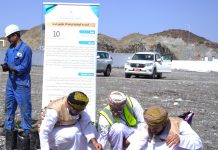The mining sector in Oman identifies as one of the top five primary sectors with the potential to carry out economic diversification. The sector has seen a robust increase in investments of late, in the wake of this agenda. The mineral-rich Sultanate has an abundance of metallic – Copper, Chromite, and Laterite, and non-metallic – Gypsum, Limestone, Gabbro, Marble, Kaolin, Quartz, Clay, Basalt, Potash, and Dolomite – deposits. The discovery of these essential mineral resources has triggered an array of large-scale exploration, mining, and extraction projects.
Public Authority for Mining
The public authority for Mining (PAM) was founded in 2014 by Royal decree, as the regulator and strategist for Oman’s growing minerals and mining industry. In 2018, PAM conducted a six-week long mining lab, that shared discourse on best strategies to apply in order to increase investments in the mining sector. PAM concluded the symposium with fruitful results – a plan for approximately 43 projects with an estimated value of RO813mn, a whopping 99 percent of the initiative to be carried out by the private sector.
Investment Incentives
In order to boost the economic contribution of the mining sector to its economic diversification plans, Oman wants to boost investments within the sector. The Sultanate has introduced new legislation which dictates that investors can acquire mining permits under a more transparent legal framework. Investors will also be able to enjoy shorter approval times and fair royalty rates. Additionally, mining permits for projects that span an area of under 5 sq. km will see an extension from one year to five years, and those that cover an area of more than 5 sq. km will be awarded an extension from 20 years to 30.
Conservation from Exploitation
To safeguard its resources from wrongful exploitation, the Sultanate has several measures in place. First and foremost, Oman’s new mining law dictates that all mineral resources within Oman’s territory, which includes exclusive economic free zones, are the property of the state. Ownership, exploration, and mining of these resources will be conducted under the watchful eyes of PAM. The law also stipulates that public tenders for mining will be issued based on merit and fair play.
Contribution to the GDP
In 2017, the mining sector in the Sultanate saw a growth of 16.4 percent. PAM has identified private sector based mining projects with an investment value of $2bn. The projects stemming from PAM’s 2018 mining lab initiative predict a projected growth of RO378mn by 2023 in the mining sector’s GDP contribution – to be three times more than its current input. The initiatives are also set to create around 1,600 new job opportunities for Omanis.
The mining sector’s growing sphere of influence within Oman’s economy will mayhap draw in more interested parties willing to invest in this burgeoning sector. Unearthing the Sultanate’s minerals has consequently also unearthed the mining sector’s potential to rise as a primary player in Oman’s economic diversification agenda.








[…] Though companies within the Sultanate are coming up with innovative solutions to tackle stagnancy, the changes need to be more rapid. The existing services offered by companies within the manufacturing and industrial sector may face a problem of short supply in the face of high demand. The world market is advancing and local consumers witness current trends and expect services within the country to be at par with the outside world, however, a delay in delivering said services might leave a gap that may be harder to bridge. To overcome this problem, companies within the Sultanate are tapping into new projects like developing renewable energy resources, and the government is supporting the growth of up and coming sectors like the tourism and mining sector. […]